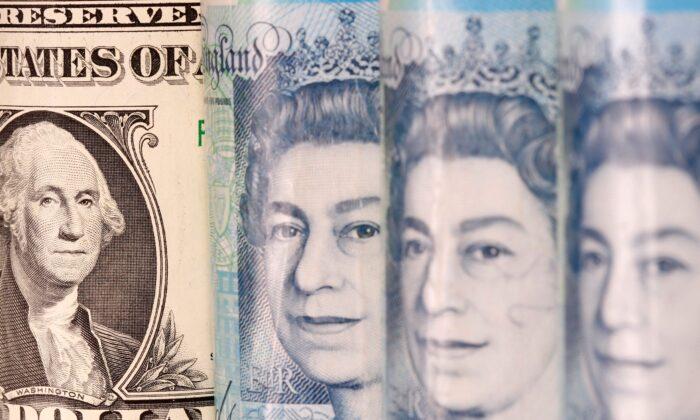LONDON—The dollar fell again on Tuesday, while risk-sensitive currencies such as the British pound gained and the Australian dollar recovered from an overnight drop.
After falling nearly 5 percent in January, world equities started February slightly firmer and currency markets have also changed course. After hitting a 19-month high last week, the U.S. dollar index fell on Monday and on Tuesday was down 0.3 percent on the day at 96.395 at 0811 GMT.
The change follows slight caution from four U.S. Federal Reserve policymakers about how many interest rate hikes will follow an expected first one in March.
The dollar also fell against the Japanese yen, with the pair at 114.990.
The Australian dollar dropped sharply overnight after the Reserve Bank of Australia (RBA) pushed back against expectations for near-term rate hikes until inflation is higher.
But the “risk-on” tone in markets meant that the Australian dollar soon recovered and was up 0.3 percent on the day at $0.70895 in early European trading.
“Those market participants who were expecting a first rate hike at the beginning of Q2 might have been disappointed,” You-Na Park-Heger, Commerzbank FX and EM analyst, said in a note to clients.
“However, a first rate step is only fully priced in for the middle of the year and that seems quite possible following the RBA’s comments today. That makes today’s RBA decision neutral to slightly negative for AUD.”
Britain’s pound was up 0.2 percent at $1.34765.
British house price growth accelerated in January, marking the strongest start to any year since 2005, mortgage lender Nationwide said.
The euro was 0.2 percent higher on the day at$1.2585.
Investors are also betting on European Central Bank rate hikes this year, despite its ultra-loose monetary policy stance.
German inflation data on Monday was well above expectations, with consumer prices rising 5.1 percent year-on-year in January, compared to 5.7 percent in December.
Eurozone inflation data is due on Wednesday.
“If the euro zone inflation data also surprises on the upside tomorrow the market might bet on a more hawkish ECB. That means EUR might find further support in the run-up to the meeting on Thursday,” Commerzbank’s Park-Heger said.
Business confidence surveys are set for release through Tuesday morning. Spanish factory activity grew in January for a twelfth consecutive month, despite persistent troubles with supply chains and price pressures.
Japan’s manufacturing activity grew at the fastest pace in nearly eight years.
The Russian rouble recovered to its strongest since Jan. 24 versus the dollar. It sank to a 15-month low last week, battered by tensions between Moscow and the West over Ukraine.
In cryptocurrencies, bitcoin was up 0.2 percent to around $38,576, still far below November’s all-time high of $69,000..
India’s finance minister said that the central bank will introduce a digital currency in the next financial year, using blockchain technology.





